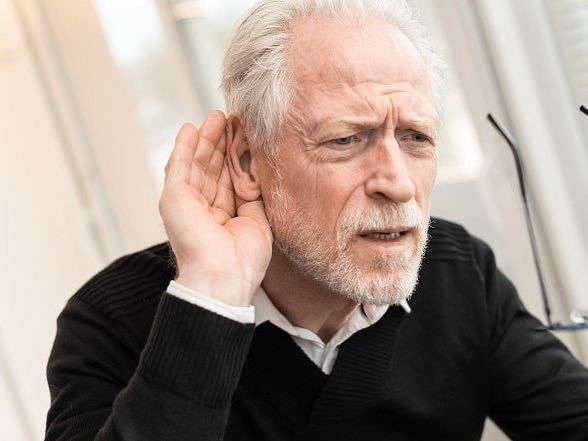Types of Hearing Loss
There are two main types of hearing loss, CONDUCTIVE and SENSORINEURAL.
Conductive
Conductive hearing loss occurs when sound waves are blocked in the outer or middle ear and can’t reach the inner ear, where hearing is still normal. This type of hearing loss is rarely severe or profound and usually affects all frequencies. People affected by conductive hearing loss often experience an overall reduction in the volume of sounds and find it difficult to hear faint sounds.
Most conductive losses are not permanent and can be treated medically or surgically. However, if left untreated, conductive hearing losses can result in permanent impairment.
Causes
The most common causes of conductive hearing loss are otosclerosis and otitis media:
Otosclerosis
Otosclerosis is the most common cause of conductive hearing loss in adults. A disorder of the middle ear bones, Otosclerosis is caused by a build-up of calcium around the stapes, preventing it from vibrating and sending sound signals to the inner ear. Over 90% of people with otosclerosis can regain normal hearing through surgical treatment.
Otitis Media
Otitis media, also called middle ear infection, is the most common cause of conductive hearing loss among children, but can also occur in adults. Otitis media, which occurs when the middle ear becomes inflamed and filled with fluid, can prevent the ear drum from vibrating properly, resulting in temporary hearing loss. This inflammation can be the result of a virus or respiratory infection. Typical symptoms include swelling, redness, earaches, irritation, hearing loss, fever and ear drainage. Most cases of otitis media can be cured by antibiotics prescribed by a physician. In some cases of persistent otitis media, surgical treatment, such as the insertion of ventilating tubes, may be required.
Other Causes
Temporary blockage (e.g. allergies, outer ear infections such as swimmer’s ear, build-up of earwax or fluid due to cold)
Perforation of the ear drum
Fractured middle ear bone


Sensorineural
Sensorineural hearing loss, also known as nerve deafness, accounts for 90% of adult hearing problems. Sensorineural hearing loss occurs when the hair cells in the cochlea (inner ear) become damaged and sound can’t reach the brain (where sound is processed). Once the hair cells have been damaged, they cannot be repaired, making sensorineural hearing loss permanent. Hearing aids can help in most cases.
Like conductive hearing loss, sensorineural hearing loss usually results in the overall reduction in the loudness of sounds. However, sensorineural hearing loss also causes sounds to become distorted.
Causes
The two main causes of sensorineural hearing loss are:
Aging
Hearing loss caused by the natural aging process is called Presbycusis. All of us gradually begin to lose hair cells as we age. As this happens our hearing becomes less acute. Around the age of 60 to 65, about 30% of the population have a hearing loss that is significant enough to affect their ability to hear everyday sounds, such as speech.
The first sign of Presbycusis is usually a reduction in the ability to hear high-frequency sounds, such as s, t, k, p, t, resulting in speech sounding muffled. This means that you can hear someone talking, but you can’t tell if they said “sit” or “kit”. Gradually the mid and low frequency tones may also be affected.
Noise-induced
Excessive exposure to noise is one of the most common – yet also one of the most preventable – causes of permanent hearing loss. Every exposure to loud noise will cause some degree of temporary hearing loss; repeated exposure over a number of years will result in the gradual, painless process of permanent hearing loss.
Noise levels are measured in decibels (dB). Sounds louder than 80 dB are considered potentially hazardous to your hearing. The following chart helps you to understand what sounds are considered too loud for healthy hearing.
| Sound Level | (dB) | Example |
|---|---|---|
| Faint | 30 | Whisper, quiet library |
| Moderate | 50 | Rainfall, quiet office, refrigerator |
| Moderate | 60 | Dishwasher, conversation |
| Very Loud | 70 | Traffic, vacuum cleaner, restaurant |
| Very Loud | 80 | Alarm clock, subway, factory noise |
| Very Loud | 90 | Electric razor, lawnmower, shop tools, subway |
| Very Loud | 100 | Garbage truck, chain saw, stereo system set above halfway mark, snowmobile |
| Extremely Loud | 110 | Rock concert, power saw |
| Painful | 120 | Jet takeoff, nightclub, thunder |
| Painful | 130 | Jackhammer |
| Painful | 140 | Shot gun |
| Painful | 180 | Rocket launching pad |
When sound reaches an intense level, it can damage the hair cells of the inner ear. This results in a loss of electrical impulses for a range of pitches. Often the damage affects the high-pitched sounds first. Consequently, high-pitched speech sounds, such as the consonants “t”, “s”, “th”, and “ch” become difficult for people to hear.
